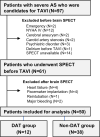Prediction of the development of delirium after transcatheter aortic valve implantation using preoperative brain perfusion SPECT
- PMID: 36327325
- PMCID: PMC9632803
- DOI: 10.1371/journal.pone.0276447
Prediction of the development of delirium after transcatheter aortic valve implantation using preoperative brain perfusion SPECT
Abstract
Objectives: Delirium is an important prognostic factor in postoperative patients undergoing cardiovascular surgery and intervention, including transcatheter aortic valve implantation (TAVI). However, delirium after transcatheter aortic valve implantation (DAT) is difficult to predict and its pathophysiology is still unclear. We aimed to investigate whether preoperative cerebral blood flow (CBF) is associated with DAT and, if so, whether CBF measurement is useful for predicting DAT.
Methods: We evaluated CBF in 50 consecutive patients before TAVI (84.7±4.5 yrs., 36 females) using 99mTc ethyl cysteinate dimer single-photon emission computed tomography. Preoperative CBF of the DAT group (N = 12) was compared with that of the non-DAT group (N = 38) using whole brain voxel-wise analysis with SPM12 and region of interest-based analysis with the easy-Z score imaging system. Multivariable logistic regression analysis with the presence of DAT was used to create its prediction model.
Results: The whole brain analysis showed that preoperative CBF in the insula was lower in the DAT than in the non-DAT group (P<0.05, family-wise error correction). Decrease extent ratio in the insula of the DAT group (17.6±11.5%) was also greater relative to that of the non-DAT group (7.0±11.3%) in the region of interest-based analysis (P = 0.007). A model that included preoperative CBF in the insula and conventional indicators (frailty index, short physical performance battery and mini-mental state examination) showed the best predictive power for DAT (AUC 0.882).
Conclusions: These results suggest that preoperative CBF in the insula is associated with DAT and may be useful for its prediction.
Conflict of interest statement
The authors have declared that no competing interests exist.
Figures




References
-
- Osnabrugge RL, Mylotte D, Head SJ, Van Mieghem NM, Nkomo VT, LeReun CM, et al.. Aortic stenosis in the elderly: disease prevalence and number of candidates for transcatheter aortic valve replacement: a meta-analysis and modeling study. Journal of the American College of Cardiology 2013; 62(11):1002–12. Epub 2013/05/30. doi: 10.1016/j.jacc.2013.05.015 . - DOI - PubMed
-
- Cribier A, Eltchaninoff H, Bash A, Borenstein N, Tron C, Bauer F, et al.. Percutaneous transcatheter implantation of an aortic valve prosthesis for calcific aortic stenosis: first human case description. Circulation 2002; 106(24):3006–8. Epub 2002/11/25. doi: 10.1161/01.cir.0000047200.36165.b8 . - DOI - PubMed
Publication types
MeSH terms
LinkOut - more resources
Full Text Sources
Medical

